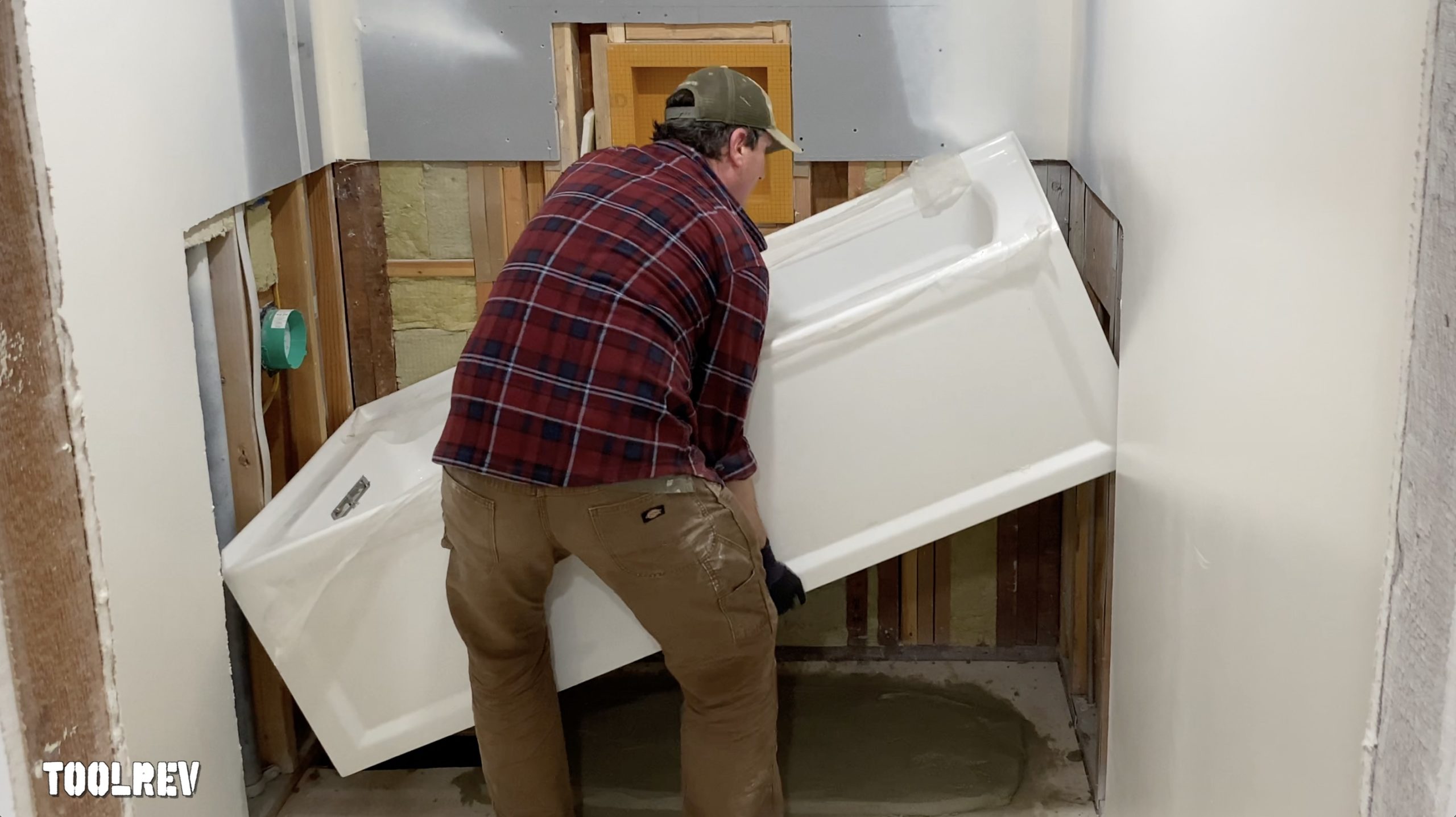We've unearthed the article on How to Install a Bathtub Yourself below on the web and felt it made perfect sense to talk about it with you on this page.

Mounting a bath tub isn't precisely rocket science, yet it does require strong plumbing, woodworking, and occasionally, tiling abilities. Replacing an old bathtub with a brand-new one is likewise a moderately tough job. If the old tub is easily available, the task can relocate quickly; if you need to open a wall to eliminate the old tub and also position the brand-new tub, the task is a lot harder. In either case, the job is within a home handyman's abilities, although you will require a helper to move out the old bathtub as well as embeded in the new one. See to it you have certified yourself for the job as well as are comfortable trying it. Rather than employing a contractor to take control of a halfway-completed project, it is far better to consider using one before you start. Chances are you may require a professional plumber to make tube connections.
This write-up will help you mount a new tub in your bathroom if you have currently bought a brand-new bathtub as well as do not need to alter the setup of your previous supply of water pipelines.
Your devices and product list ought to make up the following:
Removing Old Taps
If you need to change old faucets with new ones as a part of your setup, after that the first thing you need to do is disconnect the water system. After doing so, activate the taps to drain any type of water continuing to be in the system. The process of eliminating the existing faucets can be fairly problematic because of the limited accessibility that is often the instance.
Use a basin wrench (crowsfoot spanner) or a tap device to reverse the nut that links the supply pipelines to the faucets. Have a cloth ready for the staying water that will originate from the pipelines. As soon as the supply pipes have been removed, utilize the exact same device to loosen up the nut that holds the faucets onto the bath/basin. You will certainly require to stop the solitary faucets from transforming during this process. Once the faucets have actually been removed, the holes in the bath/basin will have to be cleaned of any old sealing compound.
Before proceeding to fit the brand-new faucets, contrast the pipeline links on the old faucets to the brand-new faucets. If the old faucets are longer than the brand-new faucets, after that a shank adapter is needed for the brand-new taps to fit.
Fitting New Taps
If the tails of the new taps are plastic, then you will require a plastic port to avoid damages to the string. One end of the port fits on the plastic tail of the tap as well as the other end offers a connection to the existent supply pipes.
If you need to fit a monobloc, then you will certainly call for lowering couplers, which attaches the 10mm pipeline of the monobloc to the basic 15mm supply pipe.
Next, position the faucet in the placing hole in the bath/basin guaranteeing that the washers are in place in between the tap as well as the sink. Secure the tap in position with the supplier given backnut. When the tap is securely in place, the supply pipelines can be attached to the tails of the faucets. The taps can either be connected by utilizing corrugated copper piping or with regular faucet ports. The former kind needs to be linked to the tap ends initially, tightening just by hand. The supply pipelines can later on be linked to the other end. Tighten up both ends with a spanner after both ends have been attached.
Setting up the Bathtub
Making use of the two wooden boards under its feet, put the bathtub in the called for setting. The wood boards are practical in equally spreading the weight of the bathtub over the location of the boards instead of concentrating all the weight onto four tiny points.
The following goal is to make sure that the bathtub is leveled all round. This can be attained by checking the level and readjusting the feet on the bathtub till the spirit level reviews level.
To mount taps, fit all-time low of the outermost adaptable tap adapter to the proper supply pipe by making a compression join; then do the exact same for the other faucet.
Turn on the water supply as well as check all joints and also new pipework for leaks and also tighten them if required. Load the tub and likewise check the overflow electrical outlet and the typical outlet for leakages.
Finally, take care of the bath paneling as explained in the manufacturer's user's manual. Tiling and sealing around the bath tub ought to wait till the bathtub has actually been used a minimum of when as this will resolve it into its final setting.
Preparing for the Setup
To start with, the supporting framework provided with the bath needs to be fitted (if required) according to the maker's guidelines. Next, fit the faucets or mixer to the bath tub. When fitting the tap block, it is very important to see to it that if the tap comes with a plastic washer, it is fitted between the bath as well as the faucets. On a plastic bathroom, it is also practical to fit a supporting plate under the faucets device to avoid pressure on the bath tub.
Fit the flexible tap ports to the bottom of the two faucets making use of 2 nuts and also olives (occasionally supplied with the tub). Fit the plug-hole outlet by smearing mastic filler round the sink outlet hole, and after that pass the electrical outlet via the hole in the bathroom. Make use of the nut provided by the maker to fit the plug-hole. Check out the plug-hole electrical outlet for an inlet on the side for the overflow pipeline.
Next, fit the end of the versatile overflow pipeline to the overflow electrical outlet. Afterwards, screw the pipeline to the overflow face which need to be fitted inside the bathroom. See to it you make use of every one of the provided washing machines.
Attach the catch to the bottom of the waste electrical outlet on the bath tub by winding the string of the waste electrical outlet with silicone mastic or PTFE tape, and also screw on the catch to the electrical outlet. Link all-time low of the overflow tube in a comparable manner.The bath ought to now prepare to be suited its final position.
Tiling Around the Bathtub
In the area where the bath meets the floor tile, it is essential to secure the accompanies a silicone rubber caulking. This is very important as the installation can move enough to break a rigid seal, causing the water to penetrate the wall surface in between the bathroom as well as the tiling, resulting in problems with dampness and also feasible leakages to the ceiling below.
You can choose from a selection of coloured sealers to blend in your components as well as installations. They are marketed in tubes and also cartridges, as well as are capable of sealing voids approximately a width of 3mm (1/8 inch). If you have a larger void to load, you can fill it with twists of drenched paper or soft rope. Keep in mind to always load the bath tub with water before sealing, to enable the activity experienced when the tub remains in usage. The sealant can split rather early if you do not take into account this motion prior to sealing.
Additionally, ceramic coving or quadrant floor tiles can be utilized to border the bathroom or shower tray. Plastic strips of coving, which are easy to use and reduce to dimension, are also quickly readily available on the market. It is recommended to fit the floor tiles using water-resistant or water resistant glue and grout.
A Step-by-Step Guide to Installing a Bathtub
Is your bathtub looking a bit dated lately? Believe it or not, installing a new one is a project you can do yourself. Whether your bathtub is broken or doesn’t fit in with your current bathroom’s design, you can fix it without having to hire a contractor or paying labour costs.
But, beyond saving money, there are other benefits of installing your own bathtub. When you do this project yourself, you can customise every step of the process. You can also make sure the finished product looks exactly the way you want it to.
This DIY project is quite involved, but by doing some research, preparing your bathroom and using the right equipment, it is definitely one you can take on. This guide will help you understand the technical procedures behind installing a new bathtub.
Remove the Existing Bathtub
To remove the old bathtub, you will need to turn the water supply off before you start any work. After you turn the water off, there will likely still be some water left in your plumbing system, which you can remove by turning on a faucet below the level of the bathtub. Once the water stops running, you are ready to start working.
The easiest way to remove the tub is to remove the faucet, handles and other piping and then pull the tub out from the wall. If this doesn’t work in your situation, you will need to remove part of the wall, remove the piping and then slide the tub out.
Choose the Right Bathtub
The ideal way to replace your bathtub is to find one that has the exact dimensions and has the drain and faucet on the same side as your old one. This way, it will fit in the same place and you won’t have to change the piping system in your bathroom. Choose a tub that matches your home’s decor and fits with the style of the bathroom.
Install the Plumbing and Ledger Board
You can purchase a tub drain kit at a hardware store which will have all the pieces you will need for your new tub’s plumbing. Follow the instructions that came with the kit to install the plumbing in the new tub and then take measurements to make sure the plumbing in the tub will align with the plumbing in your bathroom. If it doesn’t, now is the time to make necessary adjustments.
Some bathtubs need a ledger board that is installed on the wall behind the tub to help support it. If your new bathtub requires one, the directions that came with it will tell you how high it should be installed. If your old bathtub had a ledger board, and it is still in good condition, you can adjust its height to match the new bathtub.
Install the Bathtub
When the plumbing and ledger board are ready, you can install the new bathtub. Carefully lower it into the space, being careful not to damage the tub, wall, plumbing or ledger board. Since bathtubs are very heavy and you will need to line the tub up exactly, it is wise to have someone help you with this step.
Once the tub is in place, it needs to be perfectly level, so use a bubble level instead of estimating how level the tub is. Put the level on the top edge of the tub, not the bottom on the inside, since many tubs are designed with a sloped bottom.
If the bathtub isn’t level, adjust the ledger board and shift the tub until it is. When it is level, use screws to attach the tub to the wall studs. Most bathtubs have pre-drilled holes in the upper flange, so use these but do not over tighten the screws.
Hook up the Plumbing
Now that the bathtub is installed, it needs to be attached to your plumbing system. First, install the shoe fitting under the tub and drain pipe, then the overflow pipe and then the drain flange. Your tub plumbing kit will include specific instructions on how to install these pieces.
Install the Bathtub Surround
A bathtub surround will protect the walls around the tub from water damage and can give your new bathtub a more finished look. To install one, make sure the wall is completely clean and dry so that the adhesive will be able to hold the surround securely. Then, measure the surround and mark the same dimensions on the wall above the tub.
Following the directions that came with the surround adhesive, apply it to the wall. Press the surround against the wall on top of the adhesive and then pull it away for about three minutes to activate the adhesive, then apply the surround again. Keep in mind that this is the most common way to use an adhesive, but you should check the instructions on the package for any special steps.
If there is any excessive adhesive around the sides of the surround, you can use mineral spirits to remove it. Then use masking tape to hold the surround panels in place until the adhesive is dry. Using silicone, seal all the cracks between the surround panels and the gap between the bottom of the panels and the top of the bathtub.
If you want to install tile above your bathtub, instead of a bathtub surround, the process will be very similar. But, you will need to measure and cut tiles and install each one individually, using tile spacers to make sure they are evenly spaced. You will then use grout to fill in the spaces between the tiles.
https://www.hss.com/blog/bathroom/a-step-by-step-guide-to-installing-a-bathtub/

Hopefully you liked our article about Tools You Need to Install a New Bathtub . Thanks so much for taking a few minutes to browse our article. Are you aware of somebody who is interested in the subject? Take a moment to promote it. Thanks a lot for your time. Visit again soon.
Click For More Information
 Neve Campbell Then & Now!
Neve Campbell Then & Now! Alexa Vega Then & Now!
Alexa Vega Then & Now! Heath Ledger Then & Now!
Heath Ledger Then & Now! Erika Eleniak Then & Now!
Erika Eleniak Then & Now! Ricky Schroder Then & Now!
Ricky Schroder Then & Now!